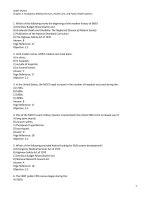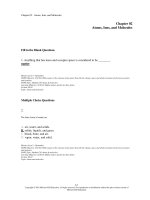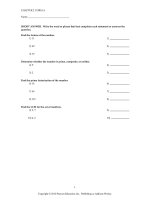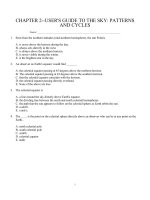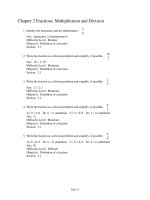Clinical laboratory hematology 2nd edition mckenzie test bank
Bạn đang xem bản rút gọn của tài liệu. Xem và tải ngay bản đầy đủ của tài liệu tại đây (300.45 KB, 11 trang )
MULTIPLE CHOICE. Choose the one alternative that best completes the statement or answers the question.
1) Which two populations account for the greatest difference in reference intervals?
1) _______
A) Whites and blacks
B) Adults and 12-year-olds
C) Newborns and adults
D) Newborns and 12-year-olds
Answer: C
2) What component of plasma assists in the transport of bilirubin?
A) Enzymes
B) Calcium
C) Hydrogen
Answer: D
2) _______
D) Albumin
3) When bilirubin is increased above the reference range, what disease process should be suspected
if liver disease is ruled out?
A) Hormone imbalance
B) Increased metabolism of hemoglobin
C) Decreased albumin
D) Increased osmotic pressure
Answer: B
3) _______
4) Which of the following can explain a decrease of erythrocytes?
A) Dehydration
B) Neutropenia
C) Blood loss
Answer: C
4) _______
D) Infection
5) Platelets and coagulation proteins are circulating components responsible for what process?
A) Hemostasis
B) Hemolysis
C) Immune defense
D) Normal cell production
Answer: A
5) _______
6) The focus of a clinical pathway is on changing structure and processes to achieve what goal?
A) Provide better patient outcomes
B) Provide assistance in difficult diagnostic cases
C) Develop better communication among the health care team
D) Decrease laboratory test utilization
Answer: A
6) _______
7) Under Medicare for laboratory testing, what codes are used for billing purposes?
A) Capitated payment plan
B) Fee for service
C) Current procedural terminology
D) Prospective payment service
Answer: C
7) _______
8) Under a capitated payment plan, the provider is decided upon by whom?
A) Health care organizations
B) The consumer or patient
C) Physicians groups
D) The insurer
Answer: D
8) _______
9) Under managed cost plans, laboratory services must be considered as what?
A) A reimbursement source
B) A cost
C) A managed resource
D) A source of revenue
Answer: C
9) _______
10) The predominant blood leukocyte found in children is the:
A) Neutrophil.
B) Eosinophil.
C) Monocyte.
Answer: D
10) ______
D) Lymphocyte.
11) The cellular component of blood that is involved in hemostasis is:
A) Hemoglobin.
B) Thrombocyte.
C) Leukocyte.
Answer: B
11) ______
D) Erythrocyte.
12) The protein found in erythrocytes that is responsible for oxygen transport is:
A) Albumin.
B) Oxygen protein.
C) Gamma globulin.
D) Hemoglobin.
Answer: D
13) Which of the following is NOT a cellular component of blood?
A) Albumin
B) Leukocytes
C) Erythrocytes
Answer: A
12) ______
13) ______
D) Platelets
14) The liquid portion of anticoagulated blood is called:
A) Whole blood.
B) Serum.
C) Plasma.
D) None of the above.
Answer: C
14) ______
15) What percentage of the total blood volume is comprised of formed elements?
A) 45
B) 10
C) 100
D) 55
Answer: A
15) ______
16) An abnormal test result is defined as:
A) The opposite of a normal test result.
B) A value that is outside the reference interval for a particular analyte.
C) A value that is above the reference range for a single analyte.
D) A value that is below the reference range for multiple analytes.
Answer: B
16) ______
17) Payment for health care services under Medicare is based on:
A) Fee for services.
B) PPS.
C) Capitated pay.
D) None of the above.
Answer: B
17) ______
18) In disease management, the term "practice guidelines" is synonymous with:
A) Critical pathway.
B) Managed care.
C) Patient-focused approach.
D) Clinical pathway.
Answer: D
18) ______
19) Which of the following is NOT a role of the clinical laboratory professional?
A) Correlate lab results with appropriate disease states
B) Order reflex tests
C) Correlate lab results with treatment
D) Correlate lab results with disease pathophysiology
Answer: B
19) ______
20) Which of the following is an expected finding in a newborn?
A) Hemoglobin = 17.0 g/dL
B) WBC count = 2 × 109/L
20) ______
C) PLT count = 100 × 109/L
Answer: A
D) RBC count = 3.50 × 109/L
21) Which of the following blood cell components would be most influenced in a patient with
ton sillitis?
21)
______
A) Erythrocyte
Answer: B
B) Leukocyte
C) Thrombocyte
D) Hemoglobin
22) Which of the following formed elements could result in hypoxia if decreased?
A) Platelets
B) Erythrocytes
C) Leukocytes
D) None of the above
Answer: B
22) ______
23) Which component of blood passes through blood vessel walls into surrounding tissues to defend
the body against invading foreign antigens?
A) Leukocytes
B) Platelets
C) Red blood cells
D) Gamma globulin
Answer: A
23) ______
24) Which of the following blood constituents is associated with increased red blood cell
destruction?
A) Blood urea nitrogen
B) Albumin
C) Immunoglobulins
D) Bilirubin
Answer: D
24) ______
25) All of the following must be taken into consideration when establishing a reference interval for a
group of individuals except:
A) Occupations of the population.
B) The geographic area.
C) Age of the population.
D) Sex of the population.
Answer: A
25) ______
26) What is the main difference between capitated pay and fee-for-service pay?
A) Amount of reimbursement
B) Type of health care providers who can participate
C) Entity controlling the service and fees
D) The selection of beneficiaries by the insurer
Answer: C
26) ______
27) What is the main difference between the clinical pathway and the critical pathway?
A) Nothing; they are the same thing.
B) Critical pathways are developed by the physicians and clinical pathways are developed by
the laboratory team.
C) Physicians are reimbursed for services based on the clinical pathway used while the
laboratory is reimbursed based on a critical pathway.
D) The clinical pathway helps determine a method of diagnosis and treatment, whereas a
critical pathway occurs after treatment has begun.
Answer: D
27) ______
28) Which of the following tests could be reflexed from an abnormal prothrombin time?
A) Hemoglobin analysis
B) Measurement of albumin
C) Complete blood count
D) Molecular analysis of clotting factors
Answer: D
28) ______
29) Which of the following could be reflexed from an abnormal RBC count?
A) WBC count
B) Prothrombin time
C) Reticulocyte count
D) Blood urea nitrogen
29) ______
Answer: C
SHORT ANSWER. Write the word or phrase that best completes each statement or answers the question.
30) Explain how a reference interval is determined.
30) _____________
Answer: A reference interval for a given region is determined by calculating the mean for a
group of "normal healthy" individuals. Conditions that must be considered
include physiologic differences in a given population as well as the geographic
area. Once the mean has been determined, a calculation to determine the standard
deviation must be done. The range is calculated by taking the mean and 2
standard deviations above and below the mean value.
31) Name three blood analytes that show significantly different results in adults, children,
and infants.
Answer: Hemoglobin is higher in infants and children than in adults. WBC counts are
higher in infants than in children and adults. Differential results are different in
children (inverted ratio of lymphs: neutrophils) than in infants and adults.
31) _____________
32) Explain how the hemostatic pathway is activated in times of need.
32) _____________
Answer: Traumatic events to body tissue stimulate the activation of repair mechanisms. As
a result of both external and internal stimuli, the hemostatic pathway becomes
activated in stages called primary, secondary hemostasis and fibrinolysis
33) List five ways to optimize laboratory test utilization to improve patient outcomes.
33) _____________
Answer: Five ways to optimize laboratory test utilization include: Development of critical
pathways, managing the test ordering system, instituting sequential testing
protocols, eliminating incorrect use of tests, and designing wellness panels.
34) Give two reasons for transfusing leukoreduced, irradiated, packed red blood cells.
34) _____________
Answer: Reasons for transfusing leukoreduced packed red blood cells are: to decrease the
risk of febrile nonhemolytic transfusion reactions, to decrease risk of HLA
sensitization, and to decrease the risk of CMV transmission. Irradiation is used to
reduce the risk of graft-versus-host disease.
MULTIPLE CHOICE. Choose the one alternative that best completes the statement or answers the question.
35) Protein synthesis occurs predominantly in the:
35) ______
A) Lysosome.
B) Cell
C) Nucleus.
D) Cytosol.
membrane.
Answer: D
36) The plasma membrane of blood cells is characterized by which of the following?
A) The hydrophilic ends of the phospholipids directed toward the inside of the lipid bilayer
B) The absence of peripheral proteins
C) Carbohydrate components (of glycolipids, glycoproteins) embededed in the lipid bilayer
D) The asymmetric distribution of the phospholipids
Answer: D
36) ______
37) Which phospholipids are found predominantly in the outer layer of the lipid bilayer?
A) Phosphatidylethanolamine and phosphatidylserine
B) Phosphatidylserine and sphingomyelin
C) Phosphatidylcholine and sphingomyelin
D) Phosphatidylethanolamine and phosphatidylcholine
Answer: C
37) ______
38) In which phase of the cell cycle is a cell quiescent?
A) The S phase
B) The R phase
Answer: C
38) ______
C) The G0 phase
D) The G1 phase
39) The point in the cell cycle after which cell division is complete but before the next round of DNA
synthesis is:
A) The G0 phase.
B) The G1 phase.
C) The G2 phase.
D) The R phase.
Answer: B
39) ______
40) In order to maintain ________, terminally differentiated blood cells undergo ________.
A) Tumor suppression; apoptosis
B) Cell regeneration; necrosis
C) Homeostasis; apoptosis
D) Cell cycle division; necrosis
Answer: C
40) ______
41) All of the following are promoters of apoptosis except:
A) TNF-alpha.
B) BCL-2.
C) Fas Ligand.
Answer: B
41) ______
D) Caspases.
42) Apoptosis plays a role in human development in all of the following except:
A) Removal of interdigital webs of the hands and feet.
B) Selection of appropriate T and B lymphocyte clones.
C) Differentiation (divergence) of mast cells and basophils.
D) Formation of the blood vessels and the gastrointestinal tract.
Answer: C
42) ______
43) All of the following are mechanisms of apoptosis in hematopoiesis except:
A) Final stages of RBC maturation.
B) Elimination of PMNs and eosinophils after an inflammatory response.
C) Progression of acute leukemias.
D) Elimination of B cell clonal populations after infection responses.
Answer: C
43) ______
44) Which cytoplasmic organelle's function is lipid synthesis?
A) Ribosomes
B) Golgi apparatus
C) Smooth endoplasmic reticulum
D) Mitochondria
Answer: C
44) ______
45) Which phospholipids are predominantly found in the inner layer of the lipid bilayer?
A) PS and SM
B) PE and PS
C) PE and PC
D) PC and SM
Answer: B
45) ______
46) In which phase of mitosis do the chromosomes align on opposite poles of the cell?
A) Prophase
B) Metaphase
C) Interphase
D) Anaphase and telophase
Answer: D
46) ______
47) The (R) restriction point occurs during what phase in the cell cycle?
A) G1
B) G2
C) S
47) ______
D) M
Answer: A
48) If an organism fails to regulate apoptosis, resulting in excessive apoptosis, which of the
foll owing
processe 48)
s might
result?
A) Carcinoma
C) Neurodegenerative disorder
Answer: C
___
___
B) Lymphoma
D) Autoimmune disorder
49) The sections of a gene which contain the coding sequences for the final protein product are:
A) UTRs.
B) Nucleosomes.
C) Introns.
D) Exons.
Answer: D
49) ______
50) Which of the following influences the stability of the mRNA and the efficiency of translation?
A) Introns
B) Exons
C) Single-nucleotide polymorphisms
D) Untranslated regions
Answer: D
50) ______
51) To be considered a true polymorphism, a SNP must occur with a frequency of:
A) >5%
B) >1%
C) >10%
D) >25%
Answer: B
51) ______
52) Structurally abnormal proteins can be eliminated from the body by tagging them with ________
and sending them to the ________.
A) Cyclins; necrosis pathway
B) CDKs; apoptosis pathway
C) Ubiquitin; proteosome
D) Caspase; apoptosis pathway
Answer: C
52) ______
53) Which cyclin component is predominant in the G1 phase of the cell cycle?
A) Cyclin B1
B) Cyclin A
C) Cyclin D
Answer: C
53) ______
D) Cyclin E
54) What protein is responsible for activating phosphorylation of all kinases involved in the cell
cycle?
A) Cdk inhibitor
B) CAK
C) Cdk
D) Cyclin
Answer: B
54) ______
55) Predict the effect of p16 on the cell cycle of dividing cells.
A) No change in the cell cycle progression
B) Decreased cell cycle progression
C) Initiate apoptosis
D) Increased cell cycle progression
Answer: B
55) ______
56) At which checkpoint would detection of unreplicated DNA strands occur?
A) G1 checkpoint
B) Metaphase checkpoint
C) S phase checkpoint
D) G2/M checkpoint
Answer: D
56) ______
57) Which regulatory protein is present in all stages of the cell cycle but has varying degrees of
phosphorylation (activation) from phase to phase?
A) p53
B) Rb protein
C) Cyclin D
D) p21
Answer: B
57) ______
58) Initiation of apoptosis occurs primarily with:
A) Activation of BCL-2.
58) ______
B) Activation of p53.
C) Stimulus from an inflammatory response.
D) Cleavage of appropriate caspases at timely intervals.
Answer: D
59) Exposure to radiation would lead to activation of which caspase pathway?
A) Common pathway
B) Extrinsic pathway
C) Intrinsic pathway
D) None of the above
Answer: C
59) ______
60) Predict the effect of the Bax:Bcl-2 complex on the apoptotic pathway.
A) The pathway will be activated and then inhibited by Bax:Bcl-2.
B) The pathway is activated by Bax: Bcl-2.
C) The pathway is not affected by Bax: Bcl-2.
D) The pathway is inhibited by Bax: Bcl-2.
Answer: D
60) ______
61) Which of the following are apoptosis activators?
A) Bak
B) Bcl-XL
61) ______
C) BCL-2
D) Mcl-1
Answer: A
62) Malignancies can result from which of the following?
A) Normal occurrence of apoptosis
B) Accelerated apoptosis
C) Inhibited apoptosis
D) None of the above
Answer: C
62) ______
63) Clearance of cytotoxic T cells after an immune response results from:
A) Inhibited apoptosis.
B) Normal occurrence of apoptosis.
C) Accelerated apoptosis.
D) None of the above.
Answer: C
63) ______
64) All of the following are potential proto-oncogenes except:
A) Proteins that neutralize growth factor receptors.
B) Proteins that bind DNA.
C) Growth factors.
D) Proteins that function as growth factor receptors.
Answer: A
64) ______
65) UTRs constitute which segments of mRNA?
A) Heteronuclear RNA
C) 3' and 5' ends
Answer: C
65) ______
B) Exons
D) Introns
66) Disposal of damaged or misfolded proteins is carried out by which cell component?
A) Lysosome
B) Ubiquitin/proteosome system
C) Molecular chaperones
D) Caspase/apoptosis system
Answer: B
66) ______
67) Cdk or kinase must be complexed with what molecule to drive one cell to the next cell-cycle
stage?
A) DNA
B) Cyclin
C) Phosphorylating enzymes
D) mRNA
67) ______
Answer: B
68) Which two proteins are critical for the effective function of the G1 checkpoint?
A) P53 and Rb
B) Cyclin E
C) P21 and p57
D) Cdk4 and Cdk6
Answer: A
68) ______
69) What feature distinguishes necrosis from apoptosis?
A) Necrosis induces inflammation.
B) Necrosis results in nuclear fragments of 185 base pairs.
C) Necrosis requires ATP.
D) Necrosis is characterized by cellular shrinkage and chromatin condensation.
Answer: A
69) ______
SHORT ANSWER. Write the word or phrase that best completes each statement or answers the question.
70) Explain in detail how p53 and Rb can contribute to the onset of malignancy.
70) _____________
Answer: Rb is the protein product of the retinoblastoma susceptibility gene, which
predisposes individuals to retinoblastomas and other tumors when only one
functional copy is present. Rb is present all throughout the cell cycle.
Phosphorylations vary with each cell-cycle phase. In its hypophosphorylated
(active) state, Rb has antiproliferative effects, inhibiting cell cycling. It does this by
inhibiting transcription factors required for the transcription of genes needed for
cell proliferation, rendering them nonfunctional. Hyperphosphorylation, on the
other hand, neutralizes (inactivates) the Rb protein, thus promoting cell cycle
division.
P53 acts as a molecular policeman; it monitors the integrity of the genome. It can
activate and inhibit gene expression depending on the target gene. It is activated
in response to DNA breakage, and slows cell-cycle division to initiate DNA repair
or apoptosis. It functions as a tumor suppressor gene, and it is the most common
mutated gene in tumors.
71) List three ways in which the caspase pathway can be activated. Explain the role of each,
and also indicate which arm of the caspase pathway will be activated.
Answer: The extrinsic pathway of apoptosis is triggered by extracellular "death" signals
(TNF, Fas Ligand, and CD95). The intrinsic pathway of apoptosis is triggered by
intracellular signals in response to stress, exposure to cytotoxic agents, and
radiation.
71) _____________
72) Describe the apoptotic pathway.
72) _____________
Answer: Death receptor binding of death receptor to cell receptor → caspase recruitment
→ activation of initiator caspases → activation of effector caspases → cleavage of
crucial cellular proteins → cell death.
73) Explain the role of epigenetic alterations in cancer development.
73) _____________
Answer: The most common epigenetic change in the development of cancer involves a
methylation/demethylation of CpG dinucleotide bases. Cancer may involve
demethylation of promoter regions of genes making them transcriptionally ready.
Methylation may result in transcriptional silencing of the gene and loss of
function of tumor suppressor genes. Deacetylation of key histones may result in
gene silencing, which may favor growth over differentiation.
74) List the four major phospholipids found in the plasma membrane of hematopoietic cells,
and explain their unique distribution.
74) _____________
Answer: The four major phospholipids that are found in the plasma membrane are
phosphatidylethanolamine (PE), phosphatidylserine (PS), phosphatidylcholine
(PC), and sphingomyelin (SM). Most blood cells have an asymmetric distribution
of these phospholipids, with PE and PS occurring in the inner layer and PC and
SM occurring in the outer layer.
1)
2)
3)
4)
5)
6)
7)
8)
9)
10)
11)
12)
13)
14)
15)
16)
17)
18)
19)
20)
21)
22)
23)
24)
25)
26)
27)
28)
29)
30)
31)
32)
33)
34)
35)
36)
37)
38)
39)
40)
C
D
B
C
A
A
C
D
C
D
B
D
A
C
A
B
B
D
B
A
B
B
A
D
A
C
D
D
C
A reference interval for a given region is determined by calculating the mean for a group of "normal healthy"
individuals. Conditions that must be considered include physiologic differences in a given population as well as the
geographic area. Once the mean has been determined, a calculation to determine the standard deviation must be
done. The range is calculated by taking the mean and 2 standard deviations above and below the mean value.
Hemoglobin is higher in infants and children than in adults. WBC counts are higher in infants than in children and
adults. Differential results are different in children (inverted ratio of lymphs: neutrophils) than in infants and
adults.
Traumatic events to body tissue stimulate the activation of repair mechanisms. As a result of both external and
internal stimuli, the hemostatic pathway becomes activated in stages called primary, secondary hemostasis and
fibrinolysis
Five ways to optimize laboratory test utilization include: Development of critical pathways, managing the test
ordering system, instituting sequential testing protocols, eliminating incorrect use of tests, and designing wellness
panels.
Reasons for transfusing leukoreduced packed red blood cells are: to decrease the risk of febrile nonhemolytic
transfusion reactions, to decrease risk of HLA sensitization, and to decrease the risk of CMV transmission.
Irradiation is used to reduce the risk of graft-versus-host disease.
D
D
C
C
B
C
41)
42)
43)
44)
45)
46)
47)
48)
49)
50)
51)
52)
53)
54)
55)
56)
57)
58)
59)
60)
61)
62)
63)
64)
65)
66)
67)
68)
69)
70)
71)
72)
73)
74)
B
C
C
C
B
D
A
C
D
D
B
C
C
B
B
D
B
D
C
D
A
C
C
A
C
B
B
A
A
Rb is the protein product of the retinoblastoma susceptibility gene, which predisposes individuals to
retinoblastomas and other tumors when only one functional copy is present. Rb is present all throughout the cell
cycle. Phosphorylations vary with each cell-cycle phase. In its hypophosphorylated (active) state, Rb has
antiproliferative effects, inhibiting cell cycling. It does this by inhibiting transcription factors required for the
transcription of genes needed for cell proliferation, rendering them nonfunctional. Hyperphosphorylation, on the
other hand, neutralizes (inactivates) the Rb protein, thus promoting cell cycle division.
P53 acts as a molecular policeman; it monitors the integrity of the genome. It can activate and inhibit gene
expression depending on the target gene. It is activated in response to DNA breakage, and slows cell-cycle division
to initiate DNA repair or apoptosis. It functions as a tumor suppressor gene, and it is the most common mutated
gene in tumors.
The extrinsic pathway of apoptosis is triggered by extracellular "death" signals (TNF, Fas Ligand, and CD95). The
intrinsic pathway of apoptosis is triggered by intracellular signals in response to stress, exposure to cytotoxic
agents, and radiation.
Death receptor binding of death receptor to cell receptor → caspase recruitment → activation of initiator caspases →
activation of effector caspases → cleavage of crucial cellular proteins → cell death.
The most common epigenetic change in the development of cancer involves a methylation/demethylation of CpG
dinucleotide bases. Cancer may involve demethylation of promoter regions of genes making them transcriptionally
ready. Methylation may result in transcriptional silencing of the gene and loss of function of tumor suppressor
genes. Deacetylation of key histones may result in gene silencing, which may favor growth over differentiation.
The four major phospholipids that are found in the plasma membrane are phosphatidylethanolamine (PE),
phosphatidylserine (PS), phosphatidylcholine (PC), and sphingomyelin (SM). Most blood cells have an asymmetric
distribution of these phospholipids, with PE and PS occurring in the inner layer and PC and SM occurring in the
outer layer.

